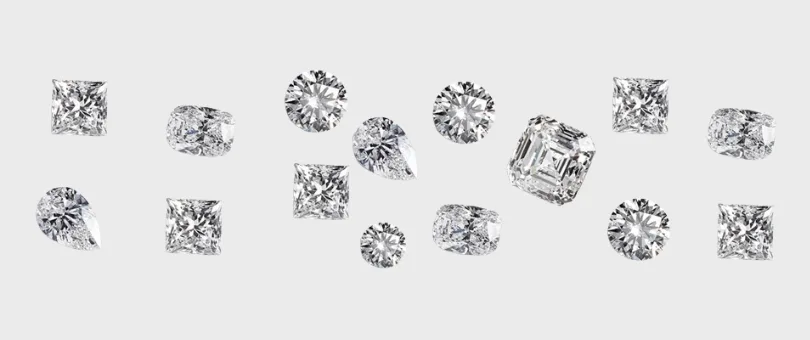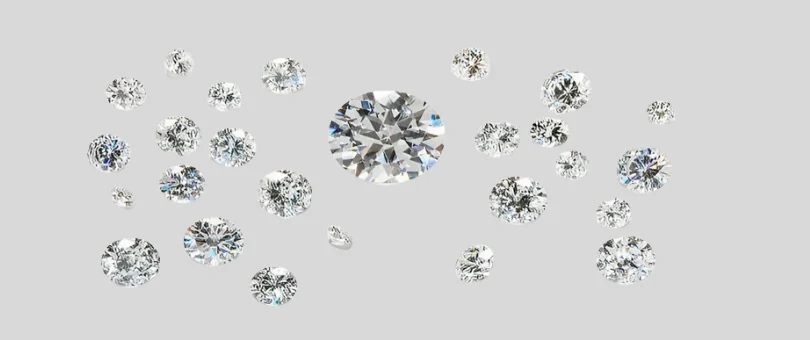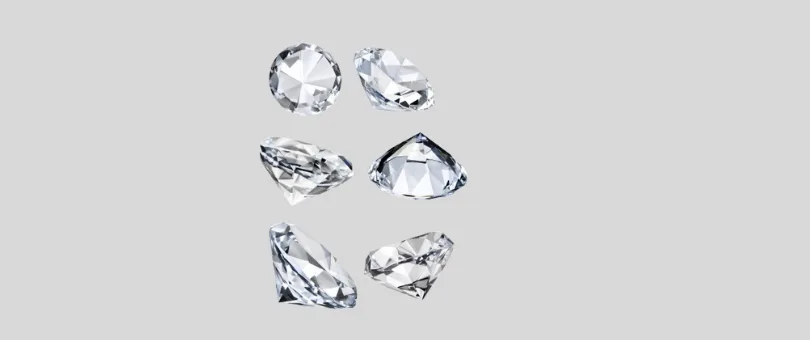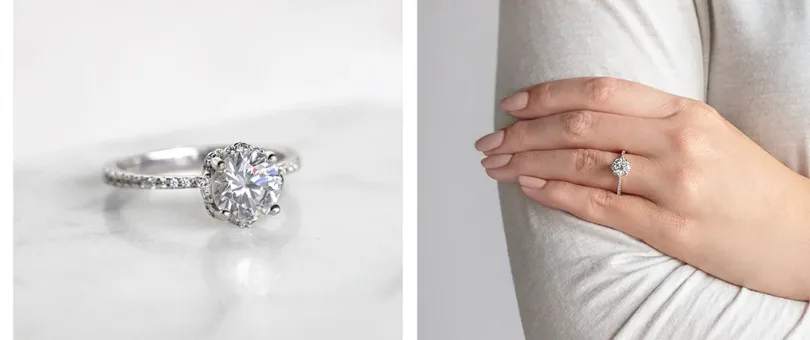Moissanite vs. Cubic Zirconia: What’s the Difference?
July 21st, 2022 / Alese Oldenburg
While some may question the ethics of a mined diamond, lab created diamonds and diamond alternatives exist to mimic a real diamond without the costs. Although the diamond alternatives moissanite and cubic zirconia aren’t natural diamonds, their stunning characteristics give their natural counterparts a run for their money. Indeed, a single glance at the sparkling diamond alternatives adorning a moissanite wedding band is sufficient to make you completely overlook the distinction. That said, not all diamond alternatives sparkle with the same sublime qualities nor blaze with the same penetrating brilliance. So, how can you define the differences between these two options?
This guide will provide insights into two widely favored diamond alternatives: moissanite and cubic zirconia. Armed with this knowledge, you’ll be equipped to choose the unique moissanite engagement ring or cubic zirconia jewelry piece that suits your preferences.
Moissanite: Stone of the Stars

From moissanite symbolism to its discovery, this stone is one of a kind. When the French chemist Henri Moissan discovered moissanite in 1893, he thought he was holding a diamond that was out of this world. It turns out he was right—at least, in part. Natural moissanite is exceedingly rare and mostly found in meteorites, making its beauty truly otherworldly. So, Henri Moissan was right: the moissanite stone is out of this world, literally. But unlike natural diamonds, which are composed of carbon, natural moissanite is composed of silicon-carbon. It has the fire, luster, hardness and brilliance to make heads turn in this solar system and beyond.
History of Lab-Created Moissanite
Just like a lab created diamond, a lab created moissanite stone has become an alternative to the ever so rare gem. Given the extreme rarity of natural moissanite, the stone wasn’t considered a suitable diamond alternative for more than a century. Then, in 1995, gemologists and jewelers combined silicon and carbon to produce synthetic moissanite. This process uses intense pressure and heat and requires specialized guidance tools to cut, polish and facet the stone. The result is an inexpensive but spellbinding stone that functions as an eye-catching diamond substitute.
In addition to jewelry, moissanite can be used in the following ways:
- High-pressure experiments – Due to the diamond’s incredible hardness, the stone has traditionally been used in science experiments that demand high pressure. However, given a diamond’s high cost, moissanite often takes its place—especially in experiments involving thermoelectric conductivity.
- Lapidary machines – Lapidary instruments—machines designed to engrave, polish and cut gemstones—increasingly rely on moissanite due to its hardness and durability.
- Consumer goods – From body armor to LED lights, moissanite is an important component of many consumer goods. Its main chemical compound, silicon carbide, has even been used in the sandpaper that comprises skateboard tape.
Now that you know the structure and history of this substantial stone, let’s explore another powerful diamond alternative: cubic zirconia.
Cubic Zirconia: The Classic Diamond Competitor

Since its widespread synthesis beginning in the 1970s, cubic zirconia has been a highly popular diamond alternative. That’s because this diamond substitute approximates the look of a diamond without breaking the bank. In its natural form, cubic zirconia is known as zirconium oxide, a yellow-tinted stone. Cubic zirconia was first discovered in this form in 1892, but it was not considered a valuable stone until the 1930s when scientists realized the stone held astounding strength and durability.
History of Lab-Created Cubic Zirconia
Until the 1970s, cubic zirconia was mainly used for industrial purposes rather than adorning rings and other jewels—that is, until a process was created to grow cubic zirconia in labs. When scientists first developed the process to synthesize cubic zirconia, it jumpstarted the stone’s popularity in the world of jewelry.
The process of forming the stone continued to evolve until scientists finally perfected the cubic zirconia synthetic process in the late 1990s. This complex process involves the superheating of zirconium dioxide to synthesize the formation of zirconia crystals. Like moissanite, natural zirconia is too rare to be used as jewelry. All cubic zirconia jewelry is lab-created.
Similar Stones, Different Attributes

Both moissanite and cubic zirconia can dazzle like a diamond reflecting moonlight. However, the two diamond alternatives differ in the following ways:
- Durability
- Color
- Fire and brilliance
- Price
Let’s break down these differences further.
Durability
When determining a gem’s durability, gemologists assign a number to the gem based on the Mohs scale, which ranks the hardness of diamonds and other gems. This number ranges from 1 (softest) to 10 (hardest), with natural diamonds at the very top of the scale.
Gemologists examine three durability aspects to determine this number:
- Hardness – A gemstone’s hardness refers to both its ability to scratch other gemstones and resist abrasions. For instance, diamond, the hardest gemstone (with a Mohs rating of 10), can only scratch other diamonds. The mineral calcite, on the other end of the spectrum, has a hardness of 3 and can be scratched by many other gemstones.
- Stability – A gemstone’s stability is a measure of its resistance to change, particularly in response to temperature, pressure and outside chemicals. Diamond is the most stable gemstone, though extreme temperature changes can result in cracks and fractures.
- Toughness – Toughness refers to the work required to break a gemstone’s bonds. While diamond’s toughness ranges from 5,000 to 8,000 on the toughness scale, the mineral nephrite has values over 225,000. However, when one factors in hardness and stability, diamond exceeds nephrite on the Mohs scale.
The Durability of Moissanite vs Cubic Zirconia
Ranking at a respectable 9.25 on the Mohs scale, moissanite is almost as durable as diamond. This means the stone is impervious to abrasions from nearly every other substance (except diamond). On the other hand, cubic zirconia has an 8.5 Mohs rating, making it less durable than moissanite. Cubic zirconia’s Mohs rating places it between topaz and corundum. Thus, while cubic zirconia approximates the natural diamond look, its relative softness makes it more prone to chips and scratches.
Color
Unlike vibrant gemstones like ruby and emerald, a natural diamond’s value is partially attributed to its lack of color. The most valuable diamonds thus astonish with complete (or near-complete) colorlessness. When gauging a diamond alternative’s color, it’s helpful to note the Gemological Institute of America (GIA) color scale. Ranging from D to Z, the GIA color scale assigns a letter grade depending on the diamond’s color saturation:
- D-H – Diamonds that fall in the D-H range are colorless or very nearly colorless. These diamonds differ only by the degree of transparency.
- I-R – Diamonds that fall in the I-R range exhibit color saturation. These diamonds exhibit deeper yellow and gray hues the farther down the scale they’re placed.
- S-Z – The most color-saturated, non-fancy diamonds, S-Z diamonds often exhibit the yellowish color of topaz. These diamonds may reflect a buttery-yellow hue.
Color Differences of Moissanite and Cubic Zirconia
Although “classic” moissanite typically falls in the J-M color range, exhibiting light yellow and brown hues, it’s possible to find colorless moissanite. That said, many people value moissanite for its ability to replicate the vibrancy of fancy diamonds—those which display vibrant colors beyond the Z range. You can typically find moissanite in nearly any color, from stunning royal purple to refined muted gray. Cubic zirconia, on the other hand, is idolized for its colorlessness. The gem typically falls in the D-H color range. However, like moissanite, you can also find cubic zirconia in an array of beautiful colors.
Fire and Brilliance
If you’ve ever been awestruck by the light reflecting off a diamond, you’ve been captured by its fire and brilliance. In short, a diamond’s brilliance is a measure of optical scintillation. It’s what makes a diamond sparkle like a thousand magnificent stars when hit by white light. Fire, however, refers to a diamond’s refraction. When white light passes through a diamond, the light disperses into the colors of the rainbow. This is what makes some diamonds shimmer with glints of red, yellow and blue. One measure of a diamond’s fire and brilliance is its refractive index, or the measure of how it reflects light. On this scale, a diamond typically ranks at about 2.4.
Moissanite and Cubic Zirconia’s Fire and Brilliance
With a refractive index of 2.9, moissanite stands head and shoulders above most other gems in terms of fire and brilliance. While it may be easier to spot the difference between the two stones due to the increased “sparkliness” of a moissanite, some still prefer it’s high level of brilliance and fire over a diamond. Cubic zirconia’s refractive index is much more modest, at 2.17. This makes the stone more “diamond-like” in terms of fire and brilliance.
Price
Natural diamonds can be one of the most expensive stones available. Diamond alternatives, however, often cost a fraction of the price of natural diamonds while simulating their intrinsic beauty.
To compare the price of moissanite vs. cubic zirconia, it’s helpful to look at their price-per-carat:
- Moissanite – With an average price of $350 per carat, moissanite is 1/34th the price of natural diamonds and 1/4th the price of synthetic diamonds.
- Cubic zirconia – At an average price of $20 per carat, cubic zirconia is 1/600th the price of natural diamonds and 1/75th the price of synthetic diamonds.
In addition to its carat, a diamond alternative’s cut will also influence the price. Round brilliant cuts tend to be more expensive, while cushion cuts are often more affordable. Whichever stone you decide on, its sparkle, brilliance, and elegance don’t stop here. Understanding how to clean moissanite ring or cubic zirconia jewelry is an important part of keeping them looking as new as ever.
Moissanite vs. Cubic Zirconia?

When you’re trying to choose whether moissanite or cubic zirconia will adorn your next piece of jewelry, it’s clear that both have their advantages and disadvantages. Moissanite is highly durable, and its fire and brilliance exceed that of a natural diamond, making it an impressive alternative. Cubic zirconia, on the other hand, approximates the look and feel of natural diamonds—but its softness makes it prone to chips and cracks.
Why Choose Diamond Nexus ?

Fortunately, there are even more stunning options for those seeking a diamond alternative that imitates the look and wear of a perfect mined diamond. If you’re in doubt, you can continue comparing diamond alternatives, like white sapphire vs moissanite or lab-created diamond vs moissanite to help you decide.
Costing up to 90% less than mined diamonds, the Nexus Diamond™ is a lab-created diamond simulant that can mirror perfect diamonds in terms of color, durability, and cut. What’s more, by choosing a Nexus Diamond simulant, you’re committing to beauty at a fraction of the cost. Welcome to Diamond Nexus, where there’s no alternative to beauty and excellence.
Sources:
Diffen. Cubic Zirconia vs. Moissanite. https://www.diffen.com/difference/Cubic_Zirconia_vs_Moissanite
Diffen. Diamond vs. Moissanite. https://www.diffen.com/difference/Diamond_vs_Moissanite
Gemological Institute of America. Diamond Color. https://4cs.gia.edu/en-us/diamond-color/
Gemological Institute of America. More than the Mohs Scale – Understanding Gem Durability. https://4cs.gia.edu/en-us/blog/more-than-mohs-scale-gem-durability
Howstuffworks. How Moissanite Jewels Work. https://science.howstuffworks.com/environmental/earth/geology/moissanite.htm
International Gem Society. Cubic Zirconia Vs. Diamonds. https://www.gemsociety.org/article/cubic-zirconia-vs-diamonds/
International Gem Society. Moissanite vs Diamond: Beauty, Durability, and Price. https://www.gemsociety.org/article/moissanite-vs-diamond/
LoveToKnow. Cubic Zirconia History: The Journey to Jewelry. https://jewelry.lovetoknow.com/Cubic_Zirconia_History
International Gem Society. Table of Refractive Indices and Double Refraction of Selected Gems. https://www.gemsociety.org/article/table-refractive-index-double-refraction-gems/

